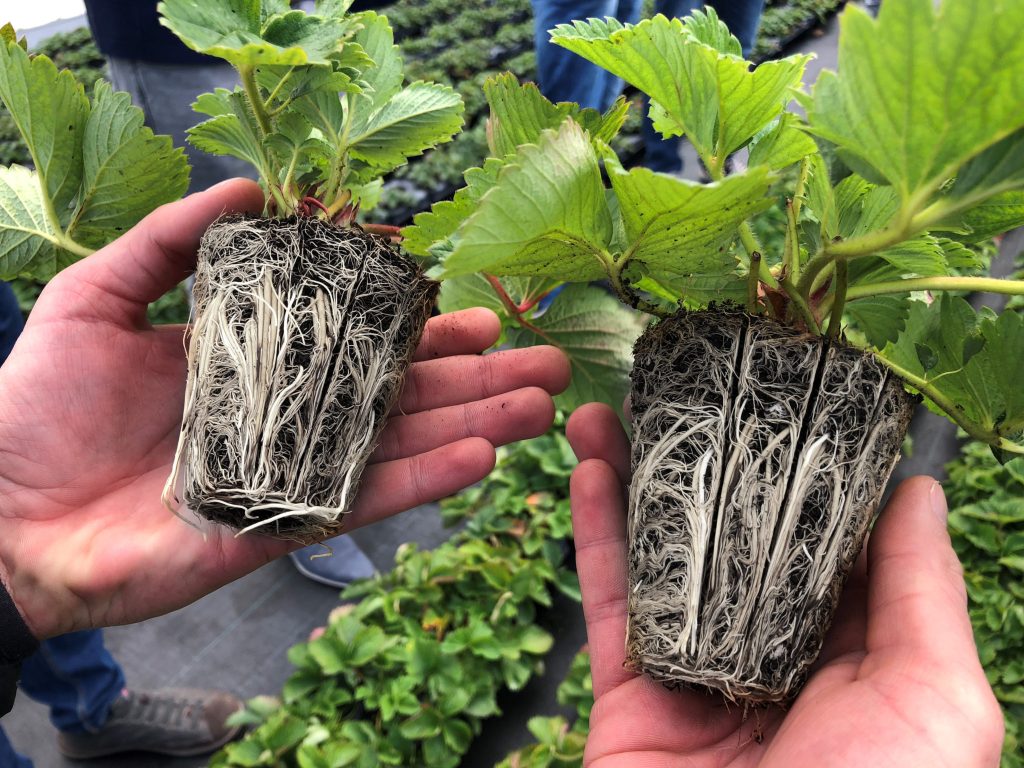Update on ongoing research strawberries
In 2012 Belgian research center “Proefcentrum Hoogstraten” and BVB Substrates started working together on new developments in strawberry growing. In 2015 tests with tray plants started.
In this article we will discuss some important recent and ongoing research. Firstly we will discuss the research into the use of our new material BVB Accretio for strawberry growing. Secondly we briefly discuss the first results of tests with reusing drain water.
The right substrates protect against fungal disease
Fungal disease Phytophthora brings quite some challenges to strawberry growers. Have a look at our previously published article by Peter Melis from the research center. This article explains more about the tests we conducted. Together we have been trying to find ways to reduce the negative effects of Phytophthora.
BVB Accretio used in substrate for strawberry plants
The first tests focussing on strawberry plants that are used for multiple years in a row were conducted in July 2018. In these tests BVB’s new raw material BVB Accretio was added to the mixtures used for the cuttings. This raw material consists of sphagnum. Sphagnum is a type of moss that grows on the top layer of peat fields and can be harvested
Sustainability
Sustainability becomes an important issue in al phases of growing. The fact that BVB Accretio is a renewable resource makes it, in addition to the excellent physiological qualities, an extremely interesting material. In addition spaghnum moss has a low specific weight. That makes it even more interesting. This, for instance, influences the environmental impact of transportation as well and results in a smaller footprint for mixtures in which it is used.
Mixtures used
We used four different mixtures in these tests. One of the mixtures consists of 50% BVB Accretio and 50% Cocos. All mixtures show good rooting and production figures. The speed at which rooting took place was best in the mixture with BVB Accretio. However, these results don’t differ much from the results of two of the other mixtures. The moss adds airiness to the mixture, which could explain the rooting speed. The speed at which the cuttings develop roots is important to fight Phytophthora.

To best measure the effect of the different mixtures, plants were dosed with a high amount of CRF fertilizers. As a result plants become more prone to be affected by the fungal disease. Even after weakening the plants, a relatively low number of plant loss was measured in the different mixtures. A loss of 8-9% was the highest number measured. The plants growing in the mixture with BVB Accretio did best. We measured a plant loss of only 2% in these plants.
Reusing drain water & optimal fertilization
In addition to this research focussing on fungal disease and BVB Accretio, we carry out other tests. For instance, we are researching the possibilities of reusing drain water. Drain water is the excess water at a tray field. This is extremely relevant because of the need for sustainability and the restrictions legislation puts on the amount of nitrate that can be in water that is discharged.
The first results of these tests are really promising. At the test field (an area of half a hectare) the test center succeeded to reuse over 92% of the water from the field. This resulted in a reduction of discharged nitrate of 98%. Together we are now researching the optimal fertilization in this situation. By reusing drain water, a part of the nutrients are reapplied to the plants with the water as well. In other words, as a result the grower applies more fertilizer. This affects the plant needs and has to be carefully researched to be able to optimise the substrates used.
Next steps
In the coming period we will repeat the tray tests with different cutting mixtures together. In addition we will continue to investigate the suitability of alternative raw materials such as wood fiber, compost and BVB Accretio.
